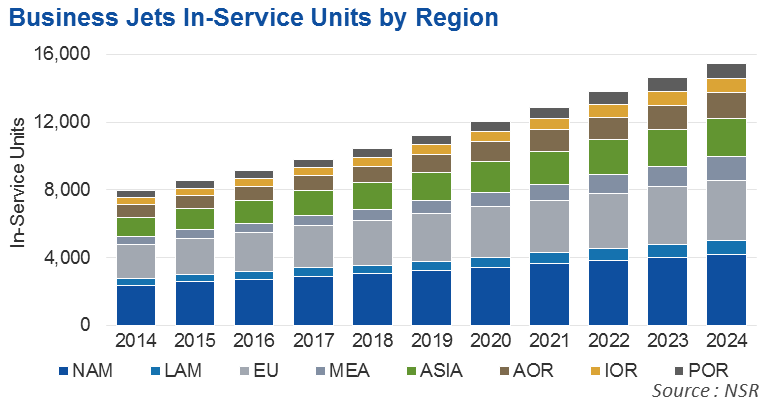Clear(er) Skies for Business Jet Connectivity
Jul 8th, 2015 by
Claude Rousseau, NSR
If contract announcements and news from airshows in
Paris, Geneva and Shanghai are any indication, business
aviation connectivity is headed for clearer skies.
And as the second largest addressable market for aero
satcom, this trend is welcome given clouds hanging over
the sector since the market crashed in 2008-2009.
A quote from a Honeywell Aerospace representative
summarized the focus on in-flight connectivity in the
business jet market: “A couple of years ago,
connectivity was in the top five, but now it’s number
one”.
At the airshows, Gogo announced the global
availability of its Gogo Vision IFE system, while
Honeywell started offering almost 3 Mbps service over
Swift Broadband. Then, ViaSat’s Ku-band Yonder
service was chosen by Gulfstream for its large business
jets, while the operator said it would have HTS
equipment certified for business jets early next year.
These announcements reflect the different needs of
owners when discussing connectivity: it’s not a
“one-size fits-all’ market.
The segment is indeed the 2nd largest
addressable aeronautical market for satcom behind
general aviation with an estimated 20,000 airframes that
could be outfitted with some form of connectivity.
Growth is solid in the segment, and Bombardier recently
upgraded its forecast for the segment to 9,000 new
aircraft in the next decade. Their numbers also
say North America will see the highest deliveries with
close to 40% of all aircraft followed by Europe, with
bigger jets and China helping drive growth. These trends
mirror NSR’s forecast in which the in-service units in
North America, Europe and Asia represent 27%, 23% and
14.5% of the total, respectively.
But to offer the broad range of solutions that the
passengers and crew alike require, service providers
such as Rockwell Collins (ARINC) and SatCom Direct have
combined offerings that enable MSS (Iridium, Inmarsat)
and FSS (Ku-band) and HTS (Ku- or Ka-band) connectivity
to live side-by-side in a diverse portfolio of
solutions. MSS remains business jets’ favorite
play as close to 12,400 in service units will generate
$150 million by the end of 2024.
But with growth being strongest in larger business
jets, which NSR sees as a prime target for VSAT (Ku-band
and HTS) capacity due to customer ability to pay and
their thirst for always-on connectivity, we expect VSAT
solutions to increase their penetration rate faster
(from a much smaller base today).

However, the move is on to help owners spend smarter
with new products for least-cost routing, efficient
operations via online diagnostics and troubleshooting,
while providing higher performing-lower cost traditional
services for voice (VoIP) and GSM (over Wi-Fi). The
low-cost services are not left behind as higher
bandwidth demand is addressed via channel bonding and
aggregation to give users faster speeds when they need
it. The example of
ViaSat and ICG integrating their systems so
customers can use Yonder for Internet and Iridium for
voice or low data rate communications let them afford
more diversity for both cabin and cockpit.
The various novelties take time to reach the market,
but services providers have gained approval for
installation of their hardware on a host of airframes of
all sizes, from the Cessna 550 through the Gulfstream
G450 to the larger Dassault F7X. And given the
replacement aircraft will grow to about 25% of the new
deliveries in the next decade, it is important to ensure
type-approval for customers that already have a solution
and are looking for an easy upgrade path.
Amongst all these new solutions hitting the market,
there remains the valid question of comparing satellite
connectivity to air-to-ground (ATG) solutions and there,
the answer is not settled. Business aviation was
the fastest growing segment for Gogo last year adding 5
times more systems in this segment than in commercial
aviation. It knows ATG bandwidth is constrained
unless new spectrum is allocated, but the signing of a
major program for fractional ownership operator NetJets
to outfit 650 aircraft with its Gogo Vision on its ATG
network is a sign that anything below 3 Mbps is still
sufficient for most users. The operator has
already installed ATG on more than 2,800 aircraft, and
the addition of new Swift Broadband units and its
leadership among Iridium resellers (more than 5,000)
certainly points to a large number of users satisfied
with connectivity below what FSS and HTS providers have
to offer.
Bottom Line
Connectivity has gone up the ladder of priorities for
owners and users of business jets, while recent aircraft
delivery forecasts show greater growth. For
aeronautical satcom, this means the biz jet segment will
grow at a faster rate than previously expected as users’
need to remain ‘online-in-the-air’ grow in part due to
more solutions available. In the end, the higher
number of connectivity options and the recent deals
announced are proof that the sky is clearing for
business jet connectivity.

